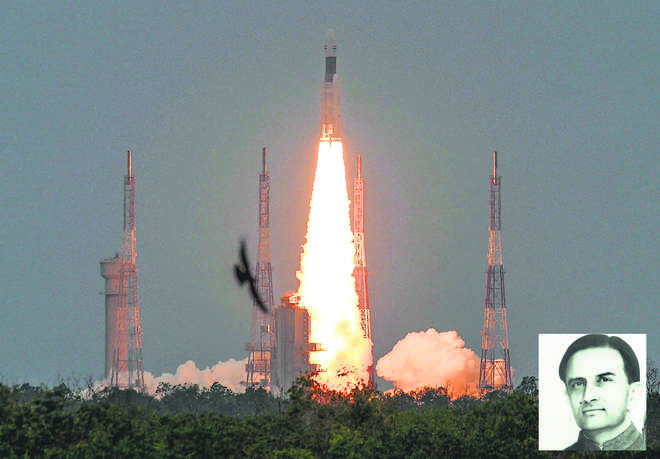
Foresight: Sarabhai’s vision made ISRO stand as a leader in societal applications of space technology, such as communication, remote sensing and weather forecast.
Dinesh C Sharma
Science Commentator
The popular discourse and excitement over Chandrayaan-2 mission is dying down, as scientists of the space agency quietly analyse the reasons behind the lost communication with the lander. Besides scientific and technological goals this mission had sought to achieve, it was special on another count. It coincided with two important landmarks in the history of our space programme — golden jubilee of ISRO and birth centenary of its founder, Vikram Ambalal Sarabhai. That’s why the lander was named Vikram.
It was the first time the space agency had named one of its missions after a leading scientist or an individual. The only exception was a meteorological satellite named after Kalpana Chawla, India-born American astronaut who had perished in the 1997 space shuttle disaster. Though the lander has failed to achieve its objectives fully, it does not take away the importance of discussing the lasting legacy of Vikram Sarabhai in the centenary year of his birth.
Sarabhai is often not counted a part of the triumvirate of Bhabha-Bhatnagar-Mahalanobis, famously credited for laying the foundation of science and technology in newly Independent India, but his contributions show that he was in the same league. He founded the Physical Research Laboratory (PRL) in 1947 for research in atmospheric physics and cosmic rays, much like the Tata Institute of Fundamental Research (TIFR), founded by Homi J Bhabha in 1945. Both these institutions were founded as private institutions but flourished as, what is today known as, public-private partnership. In 1955, TIFR became a joint venture of the Bombay government, the Centre and Sir Dorabji Tata Trust. On the other hand, PRL was started as a private laboratory but was later incorporated as a trust by four parties — department of atomic energy, Gujarat Government, Karmakshetra Education Foundation and Ahmedabad Education Society. Both these unique experiments gave birth to what India stands for in strategic S&T arena today — TIFR gave birth to the nuclear programme and PRL became the cradle of the space programme.
The approach by Sarabhai in building the space programme was innovative. In the backdrop of the intense rivalry between the two superpowers in the 1960s in the space sector, it was bold on his part to have advocated a space programme that was directly connected with people’s needs and national development. He proposed the use of satellite technology for communication and education at a time when the world was awed by the race of technological supremacy between the superpowers. He thought of applications of space technology even before India had designed a significant rocket or a satellite. For space applications, he recruited not just scientists and engineers, but also sociologists, educationists and artists. The result of all this was the unique experiment in space technology application — Satellite Instructional Television Experiment, which fructified a few years after his death. It stands as a fine example of development communication globally. It is because of his vision that ISRO today stands as a leader in societal applications of space technology, such as communication, remote sensing and weather forecasting.
Sarabhai’s involvement with scientific projects beyond space is often not fully appreciated. Among the many roles he donned after the untimely demise of his mentor, Bhabha, was the chairmanship of the Electronics Committee (popularly known as the Bhabha Committee). The panel had been set up after the 1962 War to prepare a blueprint for the development of an indigenous electronics industry, since an acute shortage of electronic parts was felt by the armed forces. The responsibility of implementing the report fell on the shoulders of Sarabhai after Bhabha. The task at hand was the planned development of an emerging industrial sector such as electronics. Here, Sarabhai applied his experience of running large industrial units as well as new management practices to what was largely seen as a scientific endeavour. He wanted Electronic Corporation of India Limited to be a commercial enterprise and not just a PSU. His vision of a PSU was not that of government-controlled entity, but a unit engaged in innovation and profit making. For this, he had advocated a kind of holding company to act as a buffer between the government and PSUs.
While the story of IBM shutting its operations in India in 1978 is well known, few would know that it was Sarabhai who first confronted the multinational in 1968 and set in motion the process to check IBM. He had firsthand knowledge of IBM’s unfair trade practices as user of its mainframe machines in PRL, and also in textile business owned by his family. When the matter of IBM applying for a licence for making a new version of data processing machines was referred to the Electronics Committee, Sarabhai got the matter examined by an expert panel. The panel recommended that IBM should bring the latest machines instead of dumping used machines and also delink its computer sale from maintenance (greater part of its revenues then) — contentious issues on which IBM was reluctant to budge.
The Ahmedabad Textile Industry Research Association was yet another unique venture of Sarabhai in which textile mill owners formed a cooperative to conduct research. This was unlike the fully-funded national laboratories under the Council of Scientific and Industrial Research. He took the same approach for building an Indian management school. The Ford Foundation and Harvard Business School came together to establish IIM-Ahmedabad. Sarabahai, much like Mahalanobis, was well networked with peers and institutions globally, ranging from MIT and Harvard to NASA and the National Science Foundation. He harnessed these links to build a plethora of institutions in India, along with links with industrial and political elites at home. India today misses such well-rounded institution builders with an international outlook and reach.



























